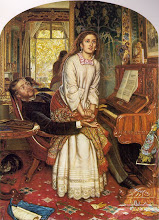A. E. Housman wrote his poem cycle A Shropshire Lad in 1896, so this excerpt is not really about World War I; but I can't hear George Butterworth's bittersweet setting of it without thinking of it as prophetic of the composer's own death in the Battle of the Somme, and the deaths of so many others in the flower of their youth.
The lads in their hundreds to Ludlow come in for the fair,
There's men from the barn and the forge and the mill and the fold,
The lads for the girls and the lads for the liquor are there,
And there with the rest are the lads that will never be old.
There's chaps from the town and the field and the till and the cart,
And many to count are the stalwart, and many the brave,
And many the handsome of face and the handsome of heart,
And few that will carry their looks or their truth to the grave.
I wish one could know them, I wish there were tokens to tell
The fortunate fellows that now you can never discern;
And then one could talk with them friendly and wish them farewell
And watch them depart on the way that they will not return.
But now you may stare as you like and there's nothing to scan;
And brushing your elbow unguessed-at and not to be told
They carry back bright to the coiner the mintage of man,
The lads that will die in their glory and never be old.
Monday, May 26, 2014
In Memory of the Dead
Subscribe to:
Post Comments (Atom)











4 comments:
That's lovely. What war was he referring to, do you know?
I don't think Housman was specifically referring to war. The poems in A Shropshire Lad that i know -- and I really only know them because they were set to music by Butterworth and several of his contemporaries -- are all very fatalistic, and his brand of English pastoralism is tinged with a sort of presentiment of death. I wonder if he, like many in Europe at the time, could foresee that the nineteenth century would end in a bloody cataclysm.
I wonder. I'm dimly remembering reading something about how in America there was a late-nineteenth century sort of attack of nostalgia for pastoralism and for 'savage peoples' being wiped out. Well, I guess it's all sort of part of the Romantics and a reaction to the Industrial Revolution. Still, I wonder about the death imagery. They're very specifically war-images.
I don't know if I'd say they're specifically war images. Housman's most recent war would have been the Crimea, and the Boer War was around the corner, but there were colonial skirmishes. But there were other ways that young men died in their prime in the nineteenth century, too.
Perhaps he was just thinking of the inevitability of death, which swallows up branch, bud, and flower.
Post a Comment